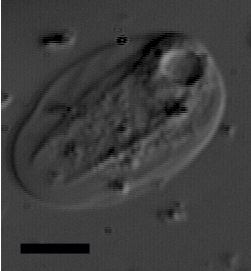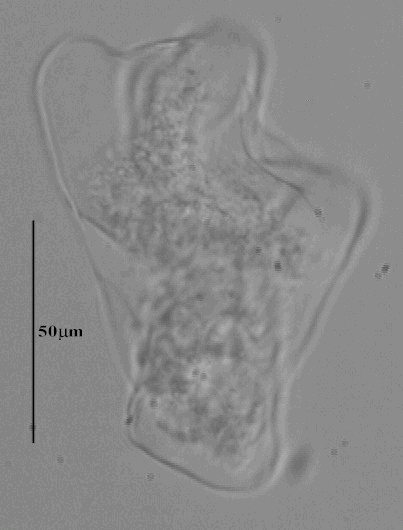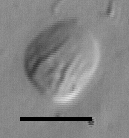Thecamoeba |
|
Page
updated 21/8/02 |
| Oval, flattened
amoeba with wrinkled appearance, sometimes resembling flabellate amoeba
(e.g. T. orbis). Present in both freshwater and marine
environments, but more common in freshwater. Singh and colleagues have
described at least three genera that Page () has suggested to belong to
Thecamoeba: Carteria bengaliensis (Singh
et al, 1982a), Greeffia
soli (Singh & Haumaiah, 1979),
and Sahnium lucknowensis (Singh
et al, 1982b). |
|
 Thecamoeba
at the Protist Information Server Thecamoeba
at the Protist Information Server
Thecamoeba sp.
Freshwater pond Penciuk, S.E. Scotland.
Amoeba moving towards the bottom left, prominent contractile vacuole
towards rear. Bar=20um.
Figure 1. |
 |
 |
Figure 2.
The amoeba on the left is a very large Thecamoeba
isolated from moss. This particular amoeba had the appearance of
vacuum packed mince with an ill fitting hyaline coat. It seemed to be
feeding on unicellular algae. |
|
The glycocalyx is thick but
not organised into discrete units as Vannella. Thecamoeba
from terrestrial and freshwater tend to be large amoebae generally being
more than 50mm in length, whereas so far, those
from seawater have tended to be smaller (Page
& Blakey, 1979), but this might
be because one particular small Thecamoeba (T. orbis) is
very common (Page 1983;
Rogerson & Gwaltney, 2000).
There have been many named species but for the majority of these the
validity is not certain. The genus Sappinia is similar to Thecamoeba
but it tends to be bi-nucleate and is supposedly sexual. As far as I know,
no genetic information is known for any member of the genus. This
will be hampered by the fact that many Thecamoeba feed on other
protists including other amoebae (the presence of other eukayotes is a
problem as PCR using the usual primers may amplify the SSUrDNA organisms
other than the Thecamoeba under study). The contractile vacuole has been
suggested as a tool for differentiating Thecamoeba (see T.
quadrilineata below), from Nuclearia
and Mayorella (Patterson,
1981), however some (e.g. T.
orbis) do not have contractile vacuoles. Attempts have been made
to differentiate members of the genus by nuclear structure and division
patterns (Singh et al, 1981).
These studies lead to the suggestion that the genus could be split between
those that had a Feulgen-negative nucleoli or nucleolus giving rise to
polar masses with the nuclear membrane remaining - this is known as
promitosis, the other group Feulgen-negative nucleoli or nucleolus and the
membrane disappear and a spindle forms organising chromosomes as in
animals and plants. The exact details of cell division in the amoeba
and protist in general are difficult as these organisms tend not to have
much DNA and a high level of other material that stains with DNA
intercalating agents both chromatic and fluorescent (See Specific
Stains for the Amoebae).
|
| Named Strains:- |
|
T. hilla
32-68mm
in length (x 50mm) (Page,
1983). A single central
nucleolus. Marine, oblong with visible longitudinal folds. Estimates (Page,
1983), put the length between 11-25mm
with some very large individuals at 30mm, while
another put the average figure at 19.5mm (Rogerson,
1991). However, Smirnov (Smirnov,
1999) found a Baltic strain that was
between 9-12mm, within the range of the isolate
shown. T. orbis feeds on flagella and bacteria (Schaeffer,
1926). Nucleus 3-6mm
in diameter with a single nucleolus (Page,
1983). No floating form has been
commented upon.
|
|
T. orbis 11-25mm
in length (x 16mm) (Page,
1983; Page
& Blakey, 1979). Marine, looks
like flabellate amoebae but with longitudinal folds. The form in
locomotion is oval or circular with the anterior half, a hyaline flattened
area, and the posterior granulated half containing the nucleus thicker.
The longitudinal folds extend from the rear towards the leading edge, but
usually not quite at the edge. These folds usually number between 2 and 5
and appear to be quite stable. From North sea
(Europe), Baltic (Smirnov, 1999),
W.N. Atlantic, Indian ocean and Gulf of Mexico it is the most
common marine Thecamoeba according to Page (Page,
1983). The size of T. orbis
is variable, the specimen in figure 3 was isolated from a supra-littoral
rock-pool at Yellowcraigs, S.E. Scotland, and at 11mm
in length is slightly smaller than a typical T.orbis. Schaeffer (Schaeffer,
1926), reported a length between
20-30mm, other estimates (Page,
1983), put the length between 11-25mm
with some very large individuals at 30mm, while
another put the average figure at 19.5mm (Rogerson,
1991).
|
 Figure 3
Figure 3
Thecamoeba orbis
bar =10mm.
Cell moving towards the upper right. |
|
However, Smirnov (Smirnov, 1999)
found a Baltic strain that was between 9-12mm,
within the range of the isolate shown. T. orbis feeds on flagella
and bacteria (Schaeffer, 1926).
Nucleus 3-6mm in diameter with a single nucleolus (Page,
1983). No floating form has been
commented upon. The nucleus of T. orbis is often not visible
in the living amoebae.
|
|
T.
quadrilineata 35-100mm
in length (x 50mm), a tendency for very large
forms in culture. Not very wrinkled in appearance. Floating
forms with banana like pseudopods. A single prominent contractile vacuole
often seen. The behaviour of the contractile vacuole of T.
quadrilineata (CCAP1583/7) has been studied in detail (Patterson,
1981). Nucleus with single central nucleolus.
|
|
T. similis
30-80mm in length (x
50mm)
Broader than most Thecamoeba.
|
|
T.
sphaeronucleolus 80-130mm
in length (x 100mm) Nucleolus often in 2 or 3
parts.
|
|
T. striata
30-80mm in length (x
50mm)
Very similar in appearance to T.
quadrilineata but no large forms and difference in nuclear structure.
(Page, 1988).
Nucleus is elliptical with parietal lobes.
|
|
T. terricola
60-200mm in length (x
110mm)
(Page, 1988).Oblong
like T. verrucosa with an oblong nucleus, with multi-lobed
nucleolus often parietal.
|
|
T. verrucosa 80-130mm
in length (x 100mm) (Page,
1988).Oblong, but baggy appearance
with a defined uroid gathered and contracted as in T. terricola.
|
| Strains available:- |
|
| T. similis CCAP
1583/8 Page 1974, Soil Wandlebury wood, Cambridge, England. |
| T.
sphaeronucleolus CCAP 1583/3 Page 1969, Lake, Tuskegee, AL.USA |
| T. striata CCAP
1583/4 Page 1969, Freshwater, Rock river, Janesville, WI, USA |
| T. terricola CCAP
1583/9 Page 1974, Soil Wandlebury wood, Cambridge, England. |
|
|
| References:-
Bovee, E.C. (1960). "Studies on feeding
behaviour of amebas. 1. Ingestion of thecate rhizopods and flagellates by
verrucosid amebas, particularly Thecamoeba sphaeronucleolus. J.Protozool.,
7: 55-60.
Page, F.C. (1971). "A comparative study of
five freshwater and marine species of Thecamoebidae." Trans.Am.Microsc.Soc.
90: 157-173.
Page, F.C. (1977). "The genus Thecamoeba
(Protozoa, Gymnamoebia): Species distinction, locomotive morphology and
protozoan prey." J.Nat.Hist., 11: 25-63.
Page, F.C. & Blakey, S.M. (1979). "Cell
surface structure as a taxonomic character in the Thecamoebidae (Protozoa:
Gymnamoebia). Zool. J. Linn. Soc. 66: 113-135.
Page, F.C. (1983). "Marine gymnamoebae"
Inst.Terr.Ecol. NERC, Cambridge, England.
Patterson, D.J. (1981). "Contractile vacuole
complex behaviour as a diagnostic character for free-living amoebae."
Protistologica 17, 243-248.
Rogerson, A. (1991). "On the abundance of
marine naked amoebae on the surface of five species of macroalgae." FEMS
Microbiol.Ecol. 85, 301-312.
Rogerson, A. & Gwaltney, C. (2000).
"High numbers of naked amoebae in the planktonic waters of a mangrove
stand in Southern Florida." J.Euk.Microbiol. 47(3):
235-241.
Sawyer, T.K. (1975). "Marine amoebae from
the surface waters of the Chincoteaque Bay, Virginia: one new genus and
eleven new species within the families Thecamoebidae and Hyalodiscidae."
Trans.Amer.Microscop.Soc. 94: 395-400.
Singh, B.N.,
Mistra, R., & Sharma, A.K. (1982a). "Nuclear structure and nuclear division as the basis for the
subdivision of the genus Thecamoeba Fromental, 1874." Protistologica
17(4): 449-464.
Singh, B.N. &
Hanumaiah, V. (1979). Studies on pathogenic and non-pathogenic amoebae and
the bearing of nuclear division and locomotive form and behaviour on the
classification of the order Amoebida. Mongraph No. 1.
Association of Microbiologists of India. Ind.J.Microbiol.
1-80.
Smirnov, A.V. (1999). "An illustrated survey
of gymnamoebae isolated from anaerobic sediments of the Niva bay (The
Sound)." Ophelia 50(2), 113-148.
|
|
